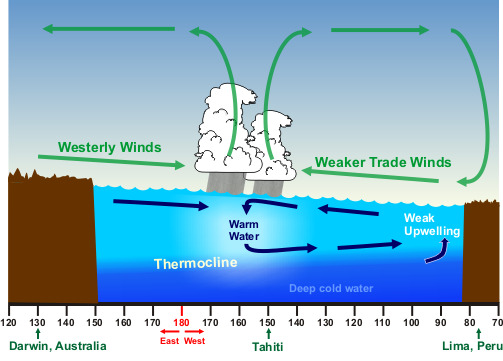 Another day, another rain storm. Rain has become the norm throughout May here in Colorado. It feels more like our typical mid–summer monsoon weather than mid-May. Normally, May is dry and filled with sunshine as we gear up for summer. So what’s the cause of all this rain and snow in the high peaks? It’s back….
Another day, another rain storm. Rain has become the norm throughout May here in Colorado. It feels more like our typical mid–summer monsoon weather than mid-May. Normally, May is dry and filled with sunshine as we gear up for summer. So what’s the cause of all this rain and snow in the high peaks? It’s back….
The it is El Nino. El Nino is technically defined as the warming of the ocean’s water caused by a change in trade winds. But what El Nino means for weather and how it will impact where we live is defined far differently. How El Nino will impact our weather here in Colorado is unknown. Because we are located so far inland, it has less impact than many think. However, there is one strong correlation if you look at past El Ninos, and that is stronger upslope storms for the Front Range. Some of our biggest snow storms occurred during El Nino years. We’re already experiencing that flow of moisture right now in the form of rain. It’s been about six years since we had a big upslope snow storm in the fall and it will be interesting to see the effects of this El Nino next October and November.
Scientists are talking about this coming year being a “significant” El Nino. The last strong El Nino was 1997-1998, which evokes strong memories for me, but not in terms of Colorado weather. Rather, I was living in the mountains of the Sierra in Lake Tahoe at the time. I distinctly remember that year for the incredible amount of snow that fell, particularly in the month of February. I was sharing a house with a guy in Kings Beach, a small town located at lake level on the north side of the lake. Typically, Kings Beach receives less snow than other areas around the lake, because it is lower, and is known as being in the “banana belt.” But not that winter.
My roommate was rather frugal and was one of the few people I knew who didn’t have a snow blower or pay for someone to regularly plow for him. Up until that winter, I guess it hadn’t been that much of a problem because he had 4-wheel drive and it wasn’t too snowy. I, on the other hand, had a 2-wheel drive car and had to “chain” up during snow storms. Well, in February, we kept getting snow storms 2-3 days apart, dumping 2-3 feet of snow or more each time. Not to be deterred, I would get up early and shovel the drive way so I could get my car out. Finally, the banks of snow got so high, I could no longer hoist the snow up, and had to resort to walking it across the street and dumping it there. One night, after shoveling snow all day at my job at the ski resort, I drove home to find a 4-foot berm across the driveway. My roommate was standing in the driveway, and I lost it. I yelled out the car window, “I’m leaving! I can’t do this anymore!” and sped off. I spent the night at my boyfriend’s house, who did have plow service. The next day I called a plow driver, arranged to have him clear the driveway for $40. It was the best money I ever spent.
I’ve never seen so much snow as that winter in Lake Tahoe. Kirkwood Ski Resort, which is located on the south side of the lake, received almost 900 inches of snow that year. We went backcountry skiing in Lassen National Park, (located north of Lake Tahoe) in March, and the banks of snow along the road were almost 30 feet high. They didn’t open the road through the park until August 3, because there was so much snow to plow. The first floor of my friend’s house were walled in by snow, and you could literally climb out the second floor windows right onto the snow.
Even though it eventually stopped snowing, the snow took forever to melt. I was working as a Park Ranger in Sequoia National Park that summer. Visitors had reserved camping spaces at the Lodgepole campground for Memorial Day, only to find themselves snow camping. As rangers, we struggled to do any outdoor nature hikes because of the snow-covered trails. Finally, with 4th of July weekend fast approaching, a group of us shoveled the benches out at the amphitheatre, so we could finally do evening campfire programs.
Of course, given the severity of California’s drought, I’m sure they would welcome all that snow. But El Nino can bring extremes of another sort – for all the moisture it can bring to California and the south, it can also bring severe droughts to Australia and Indonesia. We don’t know exactly what will happen, but one thing’s for sure, El Nino will surely bring some interesting and extreme weather that almost of all us will experience wherever we might live.

